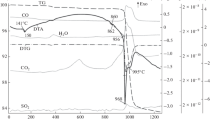Abstract
Uranium metal was prepared by reacting an oxide (UO2 or U3O8) with graphite powder under vacuum conditions. U3O8 prepared from production grade UO3 gave the highest uranium content per unit volume of charge compared to other uranium oxide sources.
The process consists of two separate vacuum induction heating steps. The first step involves heating a stoichiometric mixture of oxide and carbon in a graphite crucible to temperatures in the range 1550–1950°C to prepare an electrically conducting intermediate product. The final, or refining, step to obtain the metal consists of heating this intermediate product by self-induction at temperatures in the neighborhood of 2200°C in an urania crucible.
When a mixture of U3O8 and carbon is being heated, considerable reaction takes place at temperatures well below 1000°C and some CO2 is evolved. About 7.2 moles of carbon per mole of U3O8 are required for complete reduction to metal. The carbon reduction of UO2 yields practically no CO2 and therefore requires a carbon to oxygen ratio of unity. The quality of the final metal is essentially the same regardless of whether UO2 or U3O8 is used as the starting oxide. The total carbon, oxygen plus nitrogen content in the metal is in the range of 400 ppm with better than an 80% overall yield on a 200 g of metal scale.
Similar content being viewed by others
References
Hrn. Prof. Klaproth, (Chemische Annalen. etc. Von Lorenz Crell) Crells Annalen, Vol. 2, 387, 1789.
H. A. Wilhelm, USAEC Report No. ISC-1076, Ames Laboratory, Ames, Iowa, 1960.
Henri Moissan: See J. W. Mellor, A Comprehensive Treatise on Inorganic and Theoretical Chemistry, Vol. 12, Longmans, Greene and Co. (New York), 1932, Chap. 63, “Uranium.”
R. B. Holden, C. I. Whitman, O. J. Blaber, and R. M. Powers, USAEC Report No. SCNC-241, Sylvania-Corning Nuclear Corp., Bayside, New York, 1957.
W. G. Smiley, Report No. NAA-SR-8507, Atomics International, A Division of North American Aviation, Inc., Canoga Park, Calif., 1963.
H. A. Wilhelm, R. V. Strain, and E. P. Neubauer, USAEC Report No. IS-1379, Ames Laboratory, Ames, Iowa, 1966.
Author information
Authors and Affiliations
Rights and permissions
About this article
Cite this article
Wilhelm, H.A., McClusky, J.K. Uranium metal by carbon reduction of oxide. JOM 21, 51–56 (1969). https://doi.org/10.1007/BF03378802
Published:
Issue Date:
DOI: https://doi.org/10.1007/BF03378802




